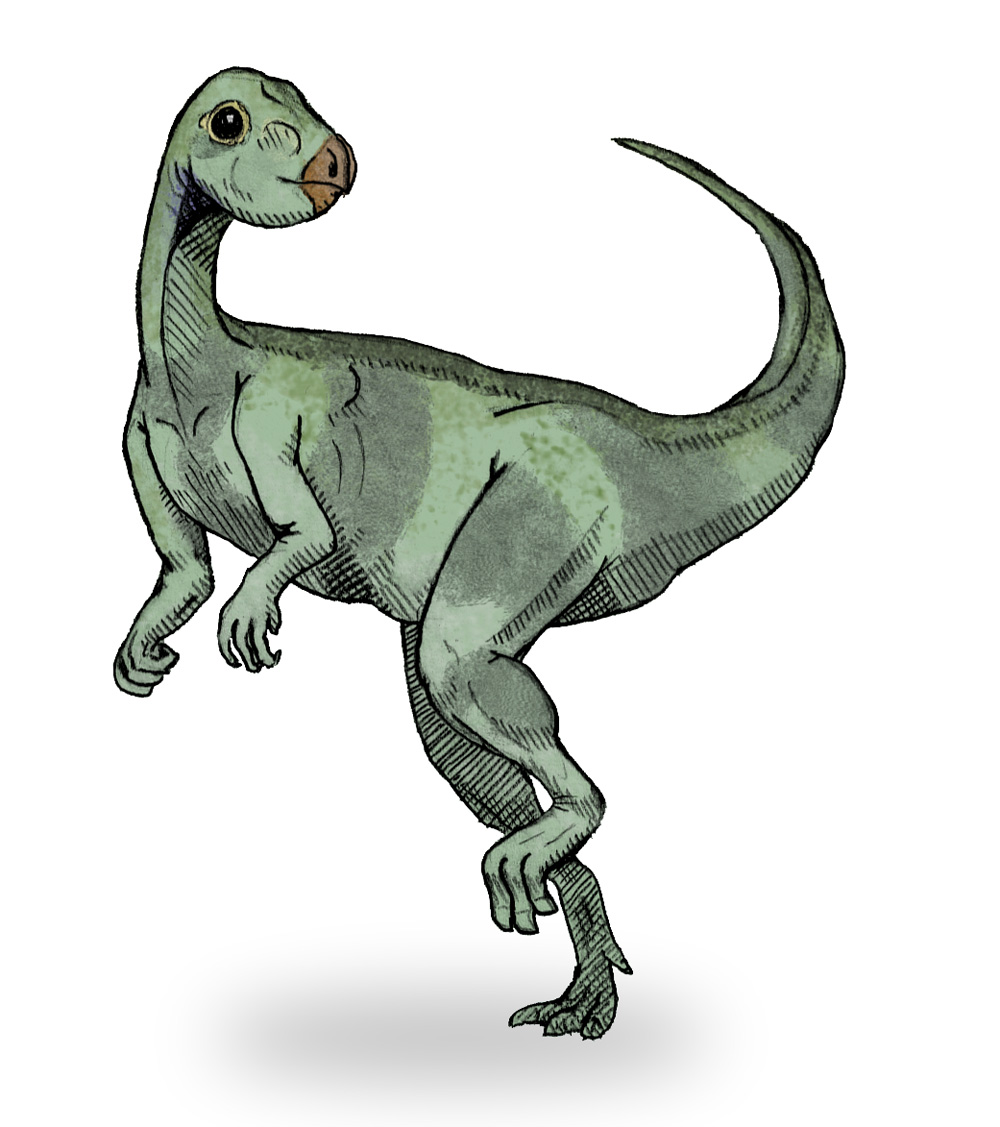- Qantassaurus
Taxobox
name = "Qantassaurus"
fossil_range =Early Cretaceous

regnum =Animal ia
phylum = Chordata
classis = Sauropsida
superordo =Dinosaur ia
ordo =Ornithischia
subordo =Ornithopoda
familia = ?Hypsilophodontid ae
genus = "Qantassaurus"
genus_authority = Rich & Vickers-Rich, 1999
subdivision_ranks =Species
subdivision =
*"Q. intrepidus" Rich & Vickers-Rich, 1999 (type)"Qantassaurus" (pronEng|ˌkwɑːntəˈsɔrəs "KWAHN-tuh-SORE-us") is a
genus of fast two-legged, plant-eating dinosaur that lived inAustralia about 115 million years ago, when the continent was still south of theAntarctic Circle . It was the size of a small grey kangaroo, and had huge eyes to help it see in thepolar night . It was discovered by Patricia Vickers-Rich and her husband Tom Rich near Inverloch in 1996, and named afterQANTAS , the Australian airline.Stub-nosed runner
:"The
jaw is unique because it is short and stocky, whereas other jaws in thatdinosaur genus are long and slender"::— Patricia Vickers-Rich"Qantassaurus" was about 1.8
meter s (6 feet) long, and about 1 meter (3 feet) high. It had short thighs and long shins, so it was probably a fast runner. Its four-toed feet had claws for traction, and the long tail probably helped with turning. One characteristic of thehypsilophodontid s and their more primitive ancestors is a spur, or "trochanter ", on the upper surface of the thigh bone (or "femur "), where muscle was attached.It only had 12 teeth in its lower jaw, while most hypsilophodontids had at least 14, so its face was probably short and stubby. It had a
beak , with leaf-shaped teeth back in its cheek, which were shed as they wore down, and replaced by new teeth growing up from the jaw.Big-eyed Gondwanan
It lived 115
million years ago inAustralia , during the late Aptian/early Albian age of the earlyCretaceous period. At the time, Antarctica was part of thesupercontinent ofGondwana , and within theAntarctic Circle . The average temperature ranged from -6 to 3 °C (21 to 37 °F), and the polar night lasted up to 3 months.They had several adaptations to survive in these conditions.
Bone growth shows thathypsilophodont ids were active all year round, so they did not hibernate through the winter. The structure of hypsilophodontid bones also suggests that it may have been warm-blooded, which would help maintain its body heat. A surprising number of Australian hypsilophodontidfossil s show signs ofdisease , which may show that they were washed away by the spring melt after failing to survive the winter.The
brain of a related hypsilophodontid, "Leaellynasaura ", indicates it had largeoptic lobe s, and large eyes, which may have helped it see in the darkpolar winter ."Qantassaurus" was probably a browser, who grabbed
fern s and other vegetation with its five-fingered hands, and ran away frompredator s like a moderngazelle . It may have had some kind of defensive camouflage, like spots.Classification
"Qantassaurus" is a hypsilophodontid, at least in the loosest sense. Newer studies indicate that the Hypsilophodontidae family is a
paraphyletic group, so it will probably be broken up.It is one of four named genera of hypsilophodontids from southeast Australia, along with "
Leaellynasaura amicagraphica", "Atlascopcosaurus loadsi", and "Fulgurotherium australe". The four species are mostly known from isolated bones and teeth; however the thigh bones of "F. australe" are very diverse and may belong to three separate genera.History
"Qantassaurus" was discovered in 1996, during the third annual field season of the Dinosaur Dreaming project, a dig jointly run by Monash University and Museum Victoria. The dig occurs at the intertidal site known as
Flat Rocks , near Inverloch, in southeastern Victoria, Australia. Geologically speaking, the site is part of the Strzelecki Group of theWonthaggi Formation . Theholotype specimen, a single lower jaw-element known as the dentary, containing several teeth (some unerupted), was found by Mrs Nicole Evered, a long time participant of the dig. Two other jaws have also been tentatively associated with the species ("referred").It was named by Patricia Vickers-Rich and Tom Rich, in honor of the Queensland and Northern Territory Air Service, which shipped fossils around the country as part of the Great Russian Dinosaurs Exhibit between 1993 and 1996, and sponsored expeditions to
South America andEastern Europe . "QANTAS" is anacronym , which is why a "u" does not follow the "q" in "Qantassaurus".Further reading
* "The Hypsilophodontidae from southeastern Australia", by Tom H. Rich, and Patricia Vickers-Rich. October, 1999. In "Proceedings of the Second Gondwana Dinosaur Symposium", edited by Y. Tomada, Tom H. Rich. and Patricia Vickers-Rich. National Science Museum Monographs, number 15, pages 167 to 180. (technical)
External links
* " [http://www.alphalink.com.au/~dannj/qantas.htm Qantassaurus intrepidus] ", from Dann's Dinosaurs.
* [http://www.dinodata.org/index.php?option=com_content&task=view&id=7306&Itemid=67 "Qantassaurus" at DinoData]
*
Wikimedia Foundation. 2010.
